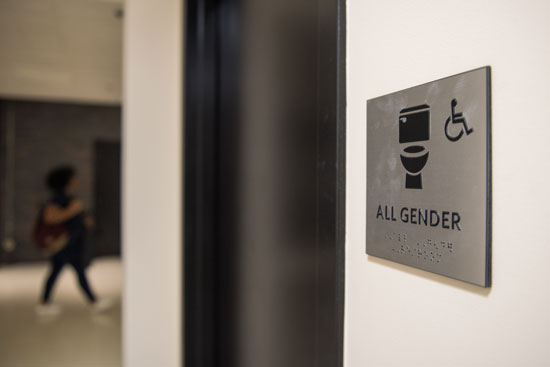BU Making More Single-Occupancy Bathrooms Gender-Neutral
“The notion of having an inclusive environment is something we're embracing,” University official says

One of the new gender-neutral bathrooms on the George Sherman Union second floor. Photo by Cydney Scott
BU senior Evan Leto still remembers feeling fear about a very mundane activity: using a public bathroom.
Just as he began transitioning to a male identity two years ago, the federal government rescinded protections that let transgender students use bathrooms and locker rooms that corresponded with their gender identity. With public bathrooms suddenly a culture wars battleground in the United States, Leto’s solution was to avoid them altogether.
“I would literally walk back to my apartment,” Leto (CAS) says. “I was afraid people would look at me in the men’s room and say, ‘You don’t belong here.’ And then the same thing would happen in the women’s room.”
BU officials, determined to make sure the University’s three campuses are welcoming and accessible to everybody, have been busy converting single-occupancy restrooms to gender-neutral ones. But with 1,537 bathrooms across the Charles River, Medical, and Fenway campuses, about half of them single occupancy, it’s a huge undertaking. Since August, the University has converted 68 single-occupancy restrooms to gender-neutral on the Charles River and Medical campuses, while an additional 32 Fenway Campus single-stall bathrooms that were not gender-specific have been relabeled with gender-neutral signs.
The work is part of an overall plan to convert all nonresidential single-occupant restrooms on campus to gender-neutral.
Michael Donovan, vice president for campus planning and operations, calls the changes a key priority for the University, which has undertaken a second review of all its bathroom facilities and how they can be adapted.
“We’re implementing signage that just calls it out,” Donovan says. “Any person, regardless of their orientation and personal hygienic needs, should have access. The notion of having an inclusive environment for the BU community is something we’re embracing.”
He says the project is a special priority for his department out of the more than 250 construction and renovation projects it undertakes annually across BU’s three campuses. He says single-stall bathrooms were targeted for conversions because they can be updated quickly.
Two new gender-neutral bathrooms on the second floor of the George Sherman Union feature new fixtures, paint, and signage, and serve as a model for future bathroom updates.
Donovan did not disclose a timeline for the changes. “We want to do more of these,” he says of the GSU bathrooms. “That is the condition we aspire to.”
Numerous studies have shown that bathrooms are among the most stressful areas on college campuses for transgender students because they are places where they are stared at, questioned, or flat-out told to leave. Research has also shown that transgender college students are at a significantly higher risk for suicide and attempted suicide when denied access to bathrooms and gender-appropriate housing on campus.
The changes actually increase the number of bathrooms available to any student or faculty or staff member on campus, and Donovan says there will still be male- and female-designated bathrooms as well.
The conversions have been met with widespread approval from staff, faculty, and students.
Crystal Williams, associate provost for diversity and inclusion, recently met with Donovan, who was clear about the path forward and the University’s commitment to it. “I’m really pleased with the direction and the clarity of the direction,” says Williams. “I feel confident in another several years, we’ll be humming along in a way that would have been unheard of two years ago.”
BU LGBTQIA Task Force member Karen Warkentin, a College of Arts & Sciences professor of biology and women’s, gender, and sexuality studies, also welcomes the changes, noting that they were much anticipated. “People are increasingly aware that this is a basic need,” she says. “It’s definitely a good thing. And I just think it’s the right thing to do.”
Although she’s never heard of an incident of gender-based harassment in a bathroom on a BU campus, Warkentin says it sends a signal to members of the University’s gender-diverse community that they matter and are welcome.
University students have been at the forefront, driving these changes. Senior Rachel Bennetts (CGS’17, CAS, GRS), an activist at the Center for Gender, Sexuality & Activism, says the changes are encouraging. Students lobbied for the changes for years, she says, and want assurances that progress will continue.
“This is a great small step addressing an issue that needs to be addressed,” she says.
Bennetts and senior Brian Stanley (CAS) coauthored a proposal called “Gender Inclusive BU: A Proposal to Improve Conditions for LGBTQIA+ Community at Boston University” and presented it to BU administrators last spring. The report advocated for the changes to the bathrooms and cited research showing how transgender students report more mental health–related issues and harassment, both verbal and physical, compared to their cisgender peers (people whose gender identity matches their sex assigned at birth).
Stanley calls the new bathrooms a necessary and much-needed improvement. “It’s great,” he says. “For so long we were just pushing for any bathroom.”
He says a campus map would be another service the University could provide to help people find the converted bathrooms more easily. Donovan says a bu.edu map identifying the bathroom locations is in the plans. “That’s a work in progress,” he says.
And Leto, the student who trudged home to avoid public bathrooms altogether? The Philadelphia native says he embraces the changes, even if they come just before he graduates.
“I know it’s super useful and important for a lot of other people,” he says. “I’m just glad it happened.”
Megan Woolhouse can be reached at megwj@bu.edu.
Comments & Discussion
Boston University moderates comments to facilitate an informed, substantive, civil conversation. Abusive, profane, self-promotional, misleading, incoherent or off-topic comments will be rejected. Moderators are staffed during regular business hours (EST) and can only accept comments written in English. Statistics or facts must include a citation or a link to the citation.